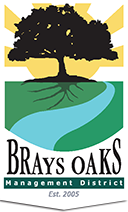
Many Houstonians know, given the last few hurricane seasons, that water and hardwood floors are not a good mix. However, a busted water pipe or leaky roof can also cause major damage. Brays Oaks Management District reached out to local business owner Joe Yeudai of Reliable Hardwoods, for his best advice for preventing permanent water damage, as well as suggestions on what your first steps should be if your home floods during a natural disaster.
“The most important thing is speed,” says Yeudai. “Those first 24 hours are critical,” as wood absorbs water like a sponge, causing warping and discoloration. Water can seep between planks into the subfloor underneath, and glued floors can loosen as the wood swells. Swift action to remove the water not only will potentially save your hardwoods, it will inhibit the mold growth that begins almost immediately after a flood event.

Best case scenario, you will only need to sand and refinish your floors afterwards. If the damage is significant and your hardwoods need to be replaced, Yeudai suggests saving a piece of flooring, along with photos to document the square footage, to show to your insurance adjuster. “After a flood, most people have so much going on with remediation that they forget to document and keep samples of their finishes,” he notes. “A lot of our clients have to fight their claim because the insurance company only wants to pay for cheaper materials, especially if the homeowner can’t prove they had high quality finishes.”
- Remove anything that is wet
Remove furniture and rugs as leaving wet materials on top of hardwoods will lead to discoloration and mold growth. - Use a wet vac to remove surface and puddled water
Remove water as quickly as possible. If damage is significant, call a professional remediation team, and consider popping baseboards to create air flow which will help prevent mold growth. - Prevent mold growth
Products that contain a mold inhibitor, like concrobium, can easily be sprayed on areas that have come in contact with water. Any visible mold growth should be scrubbed prior to spraying. - Turn on air conditioning and set up fans
Mold thrives in humidity so turning the AC up will help reduce growth. Simple oscillating or box fans will help move air and help evaporate lingering moisture. - Set up dehumidifiers
Dehumidifiers can be purchased or rented at home repair stores. Removing a few boards will help increase airflow to subfloor–reducing the chance of buckling and mold.
Remember, it can take weeks for your floors to dry completely, especially after a major flood event. Typically, the moisture content should be anywhere between 6-9% before new hardwood is installed or sanding starts. Joe also recommends having materials dropped off a few days ahead if you are replacing your floors so the wood has time to acclimate.
Joe and the crew at reliable have done great work helping folks recover from events like Hurricane Harvey at a fair price. Offering excellent service and attention to detail. You can rely on Reliable Hardwoods. Brays Oaks Management District is lucky to have such a great business in our neighborhood.








